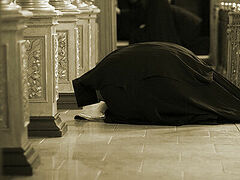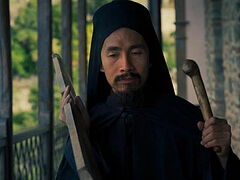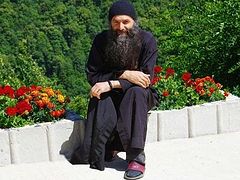The following are discussions about Holy Mount Athos, its spirit, principles, and daily routine, by several Greek archpastors who received spiritual nourishment in this monastic republic, and an Athonite who prefers not to leave Mt. Athos at all. They are convinced that no matter where one might be, everyone can find himself in this garden of the Most Holy Theotokos in the spirit.
It’s not a matter of Mt. Athos, but of Christ and our obedience
Metropolitan Athanasios (Nikolaou) of Limassol, the Orthodox Church of Cyprus:
I discovered Mt. Athos through contacts with people. At the age of eighteen I enrolled in the Department of Theology of the University of Thessaloniki, and at the same time by the grace of God I met Elder Paisios (now canonized by the Church) on Mt. Athos. When I first saw Elder Paisios, he turned out to be so simple and humble. And in his simplicity and humility was hidden his great treasure of the Holy Spirit. The elder said:
“You guys are young. So make prostrations—many prostrations.”
I was very perplexed:
“Father, how many prostrations a day should I make?”
“You are young, make a lot of prostrations,” he replied.
 Metropolitan Athanasios (Nikolaou) of Limassol
Metropolitan Athanasios (Nikolaou) of Limassol
Suddenly, in some miraculous way, everything around us began to smell sweet: rocks, stones, trees, the wind—all the nature of Mt. Athos was suddenly transformed. My fellow-student and I felt this change. Then the elder hastily closed the door behind us and quickly returned to his cell. A feeling of deep joy began to reign in our hearts. We set off at a brisk pace, heading for Karyes without stopping for rest from the joy that had overwhelmed us. The fragrance accompanied us. We were going step by step and wondering: “What does all this mean?!”
For some time I had the opportunity to observe the life of Elder Paisios and I saw miracles. Since then I have gained confidence in the reality of the Gospel, in the fact that everything that Christ said really can be put into practice.
Then, in 1976, Elder Paisios (who did not accept novices) in response to my question, “To whom then should I submit myself in obedience?” sent me to Elder Joseph of Vatopedi.
“Does Elder Joseph know how to perform the prayer of the heart?” I asked, as he slightly pushed me in the back.
“If other fathers are teachers of this prayer, then Elder Joseph is a professor,” Elder Paisios laughed at my indecisiveness. And he blessed me to become a novice of Elder Joseph.
Thus I became one of the spiritual children of Elder Joseph. I joined him, dreaming of learning how to pray. Elder Joseph was a true hesychast. He did not follow the daily routine of the brotherhood; he had his own hesychast rule, which was radically different from our rule adapted for weak brothers. But a brotherhood didn’t gather around him until later, and when I came to him I was his only novice.
I hoped that my monastic life would become exclusively a school of prayer, that the elder would immediately put me in a cell, give me a huge prayer rope and make sure that I prayed ceaselessly. And instead of that he gave me a bucket and a mop and sent me to clean the floor. And I dared not object and say: “I’m here to pray and not to mop the floor!” Otherwise I would have been shown the door at once as Elder Joseph was very strict. Elder Joseph told me just a few simple words about prayer: “Take a prayer rope, constantly pray with humility, and enclose your mind in the words of prayer.”
Soon I came to Elder Paisios with a question:
“I’ve been on Mt. Athos for about three years now. I try my best to pray, but I see no result.”
“What kind of result do you want?” He asked me.
“The kind we read about in books.”
“My cat is dead. Go and resurrect it!” he suggested to me and, seeing my confusion, added, “What do you want? To perform miracles?”
But I remembered that fragrance spread throughout the nature of Mt. Athos...
It is not a matter of Mt. Athos, but of Christ and our obedience.
Then I was told by one Athonite schemamonk how one day a young novice from his brotherhood was drafted into the army. If he were to be in an army barrack with its brash spirit and obscenities, he would have been lost for monastic life. His elder was very worried. And then this schemamonk went to the elder and said that he wanted to be sent to the army instead of that brother.
“Can you handle it?” The elder asked him.
“Yes, I’m ready. Even now.”
He immediately took off his cassock, shaved off his beard and hair, went with the police who had arrived to join the army and passed himself off as that youth. He and those who accompanied him spent a night at a hotel in Ierissos, with songs, laughter and shouts in the neighborhood. But, as that schemamonk who was older than me later told me that even without his cassock and hair he was in Paradise all that night. He never (neither before, nor afterwards) felt such abundant grace as that night again. “The Lord will not leave the one who sacrifices himself,” Elder Paisios told us. The next day, a telegram was sent from the military unit notifying the novice that it was not necessary to go to the army, and the schemamonk returned to Mt. Athos. Later he even felt sad and told me: “I have lost such grace! Because after returning here I again began to do my own will.”
Who came here to bury Mt. Athos?
Metropolitan Nicholas (Hatzinikolaou) of Mesogaia and Lavreotiki, the Church of Greece:
I remember my understanding of Mt. Athos when I was a simple pilgrim. Or, I might even say, I came to the Holy Mountain as a tourist. Of course, I was looking for something, but my inner search had no specific goal. As the Athonites say: a person does not need much—a spoon, a plate, minimal clothing—but the most necessary thing in life is a goal! At the time I had a lot in my life, but the purpose was somewhat unclear. I really liked the nature and the way of life on Mt. Athos. And I found its people appealing too—they were different.
 Metropolitan Nicholas (Hatzinikolaou) of Mesogaia and Lavreotiki
Metropolitan Nicholas (Hatzinikolaou) of Mesogaia and Lavreotiki
Before 1968, life on Mt. Athos was declining, buildings were crumbling, and monks of advanced age were living out their days. It seemed that the glory of the Holy Mountain was already in the past. When the millennium of cenobetic monastic community on Mt. Athos was celebrated in 1963, one of the dignitaries put it bluntly: “We have probably come here to bury Mt. Athos.”
But soon a miracle occurred, and after five years Mt. Athos was unrecognizable. There were considerably more young monks than old ones there. Ascetic life attained new heights. Of course, this was largely thanks to such elders as Joseph the Hesychast, who trained many disciples.
When Greece joined the EU in 1981, funds were allocated for the reconstruction of Mt. Athos. This prevented most of the old buildings from turning into heaps of rubble. But it had a negative impact on the spirit of the Holy Mountain! Roads were laid everywhere as cars had to transport construction materials. Noise and dust began to disturb the solitude and the life of prayer. In accordance with the EU instructions, buildings of a certain level of comfort were constructed on Mt. Athos, bringing an element of comfort and even luxury, which had previously been unheard of in the monastic republic. For monks those circumstances provoked new temptations because the monastic life in poverty has always been regarded as a blessing of God. Cenobitic monasteries may have benefited from that reconstruction program to some extent, but the eremitic life suffered greatly from the innovations.
But, despite everything, Mt. Athos is a place of continuous, unceasing prayer. Here the grace of God is constantly manifested in the holiness of individual monks and in secret signs.
We know that all the major biblical events happened on the tops of mountains: on Mount Sinai humanity received the Ten Commandments, on Mt. Tabor the Transfiguration of the Son of God took place, and Christ ascended to Heaven from the Mount of Olives. And Mt. Athos is (spiritually) the highest point of the earth.
There are four main principles of the organization of life on Mt. Athos.
Firstly, this is anchoretic life, because monastic life on Mt. Athos is, first of all, asceticism and hesychasm. Here even the rules of cenobitic monasteries are much stricter than in other places of the globe.
Secondly, its self-administration, since Bishops do not govern Mt. Athos—they could only interfere here because the Holy Mountain is under the jurisdiction of the Patriarch of Constantinople, and more importantly, the Most Holy Theotokos Herself governs it.
Thirdly, its universal nature, since Mt. Athos is a universal phenomenon on earth. It is neither “Russian”, nor “Greek”, etc. But it unites everyone. There are the Russian St. Panteleimon’s Monastery, the Serbian Hilandar Monastery, the Bulgarian Zographou Monastery… Out of the twelve sketes two are Romanian, and there are representatives of very many nationalities among the brethren of all of its monasteries.
And, fourthly, the religious rule of Avaton is enforced by law on Mt. Athos. Women are banned the entry onto its territory. I believe that it should also forbid access by television and those curious individuals as I myself was in my time.
Give 100 percent of yourself to God to receive the same amount and more from Him
Hieromonk Anastasios (Topouzis) from Koutloumousiou Monastery:
Mt. Athos—a garden of the Theotokos—is a very important part of the earth, on which by the grace of God prayer is performed every day under the Protection of the Theotokos. And here the practice that we call hesychasm continues and develops.
 Hieromonk Anastasios (Topouzis)
Hieromonk Anastasios (Topouzis)
But this mysterious life of the Spirit is open not only to those who reside on Holy Mount Athos. As we know, in physics, there are communicating vessels. If we pour water into one vessel, in all the vessels the liquid level will be the same. This is exactly what happens in the Church.
Christ does not give us the Spirit according to our capacities. It’s only up to us. Each of us receives exactly as much as he is willing to give. How much do you devote your life to Christ? Do you devote seventy percent to yourself and only thirty percent to Christ? This means that you will receive thirty percent in return and you have lost seventy percent! This percentage shows, tentatively speaking, the degree of genuine monastic life of each of us on Mt. Athos. Because Mt. Athos is not about geography—it is about a state of the heart. You need to give all 100 percent of yourself to God to receive 100 percent of the grace of the Holy Spirit. Only in this case, when we run out everything that this world can give us and we completely exhaust our strength in the podvig of the service of love, will we have the chance to put our hand into God’s pocket and take what we need.
I wish all of us, through the prayers of our Most Holy Theotokos and the saints who lived in the hesychast tradition, to attain the state in which we can give ourselves to Christ totally and receive accordingly. Christos Anesti!




